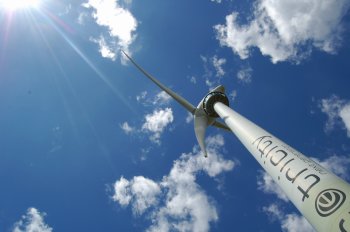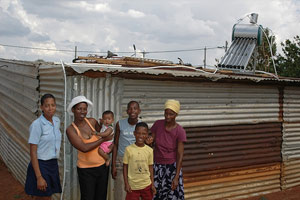The Main Advantages of Renewable Energy

The advantages of renewable energy are kind of obvious - however the interesting part (and the devil!) is in the detail. Renewable energy which requires no further input is going to be cheap, sustainable energy, you might think.
But there are also some well known disadvantages of renewable energy sources. Lets take a brief look at these first before considering the main advantages.
Renewable energy disadvantages
Renewable energy is not always created at the point of use (the same is true of fossil
fuel energy, too). If you create energy from wind at an off-shore wind
farm, the energy needs expensive infrastructure to enable it to be
brought to people's homes and to factories and offices. There is always
an inefficiency in transporting energy; a good percentage is simply lost
along the way.
In Britain there is an on-going controversy about the new super pylons which will carry electricity from wind farms and future nuclear plants. These monsters threaten to impair some of the most beautiful landscapes of our countryside (including Constable country and the Somerset levels). There are alternatives (underground conduits) but they are far more expensive, at least in the short term.
Environmentalists often favour local energy production, for these reasons. PV systems can be installed on roof tops so that most of the electricity is produced right where it is to be used.
The advantages of renewable energy are increasingly recognised by governments world wide. However, storage and transport can be issues which affect the viability of schemes.
The sun does not always shine and the wind does not always blow
Large and expensive installations may be effectively shut down for hours or even days at a time if weather conditions are not right. On cloudy days solar plants may generate only a slim percentage of output of sunnier days - and not a one of them can ever produce energy at night!
The return to cold winter conditions (and high atmospheric pressure) at the start of 2010 meant that many of the big wind turbines around Britain and north Europe could not find enough wind to power them.
Even hydro-electric power may suffer from a relative decline when hot dry summers reduce water flow. In summer of 2009 the Punjab area of India was forced to cut power supplies from hydro-electric plant so that people could have enough water for irrigation and daily needs.
European super-grid
These kinds of problems will be addressed in Europe when the proposed super-grid of renewables comes to fruition. The idea is that wind power from Denmark and the UK and from off-shore wind farms and solar power from Spain and elsewhere will all be linked by a giant electricity grid. Hydro schemes in Norway will be used to store the power for release when needed. This super-grid is at the start of planning and will cost billions - around £30/$46 billion to create (according to the Financial Times).
Large scale renewable energy projects are far from cheap. Most require massive amounts of funding and are therefore expensive in the short term. This can act as a significant deterrent to governments and investors alike. There is an increased willingness by governments to invest now that the pressures of climate change have become all too obvious. The two new wind farms planned for off the Irish sea off Britain's coast will cost in the region of 100 billion pounds - lot of money by anyone's reckoning.
Environmental problems
Other projects such as river dams for hydro-power and tidal barriers are also mega projects which require monumental amounts of money. Some of the dam projects across the world have involved exploitative deals for local people. Foreign investors have become richer at the expense of people and wildlife.
Very often the water table of surrounding areas is adversely affected. Ground water wells run dry and more people migrate to towns, putting greater strains on the infrastructure. Nigeria's Kefin-Zaki dam project has been cancelled four times, partly because of concerns about the effect upon water supplies to local farmers. Birds and wildlife would have been at risk, too.
In China 1.24 million people were forced to move from their homes to make way for the Three Gorges Dam. Although this dam is thought to lessen the likelihood of flooding in the area, there are concern about upstream erosion and downstream silt deposits reducing the stability of the river.
Biofuels, grown to replace petrol and for energy generation, can displace food crops which then has a knock on effect on the price of food. It is believed that the amount of food grown worldwide has declined by as much as 30% as biofuel crops have become more prevalent. Biofuel such as palm oil are also replacing invaluable ancient rainforests and wreaking environmental destruction on native peoples and wildlife.
For more on the advantages and disadvantages of biofuels, please see What is biofuel?
Storability
Most kinds of renewable energy are not so easy to store. One of the advantages of using fossil fuels is that energy generation can be quickly tailored to demand. See advantages below for how hydro-electricity (and kinetic energy) can be used for storing power.
So what are the advantages of renewable energy?
Here are a few pointers.
First, and most obviously, the sun will always shine, the wind will always blow and the rain will always fall - at least some of the time. Renewable energy renews itself constantly as part of nature.
Fossil fuels, on the other hand can only renew themselves only at fraction of a snails pace. We are using in a few short years a resource which took millennia to be laid down.
This has to be one of the main advantages of renewable energy; it does not run out!
Sponsored links
Less pollution and far lower carbon emissions
Here are two really compelling advantages of renewable energy: pollution and cost.
When renewables are used, the need for polluting fossil fuels is reduced. Consequently there are fewer damaging emissions with their health risks and clean-up costs.
The main pollutants which concerns everybody these days are carbon dioxide and other greenhouse gases.
Renewables themselves are almost pollution free. There is a certain amount of pollution created during construction, of course. In some cases this can be a major hazard.
Long term savings
Renewables are often cheaper in the long run. After the initial investment is paid, the running costs may be far lower. In many cases (wind, sun and waves, geo-thermal) the power sources are actually free at the point of collection. No-one has managed to put a tax on sunshine yet!
Huge investment in wind power have resulted in cheaper energy costs in the UK. These savings are not always passed on to the consumer for a variety of reasons.
Natural cycles
Many renewable energy sources use energy produced during natural cycles - so there is relatively little interference with the natural world. For example, if you put a solar PV system on your roof so that you can benefit from electricity generated, it will not affect the quality or the amount of sunlight which falls in your area. This cannot be said for all types of renewable energy. Dams which produce hydro-electric power are often massively disruptive of river systems and ground water supplies, unfortunately (see above).
Clearly we need to take a holistic approach to energy production; one which considers all, people, wildlife and long-term effects (rather than personal and corporate profit). The advantages of renewable energy include that it lends itself well to this kind of thinking.
One of the advantages of hydroelectricity is that it can be used as an energy storage system. Dinorwic, in Wales powers most of Britain's morning cuppa. Stored water in a high reservoir pours down underground channels and drives turbines 2,000 feet below by Llanberis lake (Llyn Padarn). If you visit Snowdonia, the "Power of Wales" exhibition and tour under the mountain are well worth seeing.
Sustainable power, lower energy and maintenance
Renewable energy production is generally far more sustainable and the on-going costs of production and maintenance are lower. Solar PV, for example has no moving parts so provided that there is no damage from outside, the system should continue working for many years with fairly minimal maintenance.
Some renewable energy can be produced from local and relatively local sources.
Some people see this as one of the main advantages of renewable energy. Energy generation can be really local (from the top of your house, even!) and it is not so dependent upon foreign governments. This lessens the potential threats of unstable and volatile prices, unpredictable supply and even terrorism.
Do the advantages of renewable energy out-weigh the disadvantages?
Most certainly, for the most part. But, as ever, it partly depends upon who you are and where you are.
Of the main advantages of renewable energy, probably the most crucial one for this generation and the next is the far lower carbon emissions. We need to control greenhouse gases so that our climate can be relatively stable.
In other pages we'll take a look at some of the advantages and disadvantages of the main types of renewable energy.
*****
Advantages of Renewable Energy - top of page
Energy Options - Solar Power for Homes
Greenfootsteps Home - for more easy green living ideas
The Main Advantages of Renewable Energy
Copyright Greenfootsteps.com 2010
Please do not copy without permission except for personal use.
This site is protected by Copyscape.
| Tweet |

| Tweet |


Some related pages:
Sponsored links
Footprints
- an occasional e-zine from Greenfootsteps
If you would like to receive the e-zine, please just sign up below.






New! Comments
Have your say about what you just read! Leave me a comment in the box below.